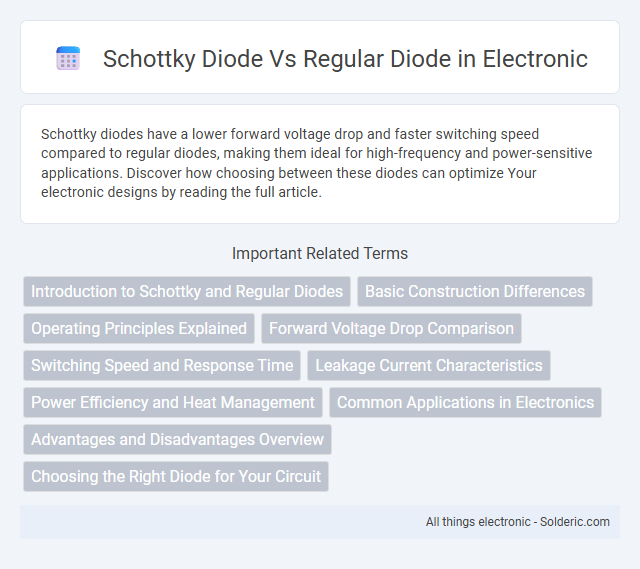Schottky diodes have a lower forward voltage drop and faster switching speed compared to regular diodes, making them ideal for high-frequency and power-sensitive applications. Discover how choosing between these diodes can optimize Your electronic designs by reading the full article.
Comparison Table
| Feature | Schottky Diode | Regular Diode |
|---|---|---|
| Construction | Metal-semiconductor junction | PN junction |
| Forward Voltage Drop | 0.2 to 0.3 V (low) | 0.7 V (silicon diode) |
| Switching Speed | Very fast (ns range) | Slower (ms range) |
| Reverse Recovery Time | Minimal | Significant |
| Leakage Current | Higher compared to regular diode | Lower |
| Applications | High-speed switching, power rectifiers | General rectification, signal processing |
| Temperature Sensitivity | More sensitive to temperature changes | Less sensitive |
Introduction to Schottky and Regular Diodes
Schottky diodes are semiconductor devices known for their low forward voltage drop, typically between 0.15 to 0.45 volts, which results in faster switching speeds and higher efficiency compared to regular PN-junction diodes with forward voltage drops around 0.7 volts. You should consider Schottky diodes in power-sensitive applications due to their minimal power loss and reduced heat generation. Regular diodes, made from a p-n junction, are widely used for general rectification and voltage blocking, offering higher reverse voltage tolerance but slower switching than Schottky diodes.
Basic Construction Differences
Schottky diodes feature a metal-semiconductor junction, typically formed by contacting a metal such as aluminum with an N-type semiconductor, resulting in a lower forward voltage drop and faster switching speeds compared to regular silicon PN junction diodes. Regular diodes consist of a P-type and N-type semiconductor junction, which creates a depletion region affecting their switching speed and voltage characteristics. Understanding these basic construction differences helps you choose the optimal diode type for high-speed or low-voltage applications.
Operating Principles Explained
Schottky diodes operate based on the metal-semiconductor junction, which allows for faster switching and lower forward voltage drop compared to regular PN-junction diodes that rely on the semiconductor-semiconductor interface. This metal-semiconductor interface in Schottky diodes results in minimal charge storage, enhancing their efficiency in high-speed applications. In contrast, regular diodes exhibit higher forward voltage and slower recovery due to their charge carrier recombination in the depletion region.
Forward Voltage Drop Comparison
Schottky diodes have a significantly lower forward voltage drop, typically ranging from 0.15 to 0.45 volts, compared to regular silicon diodes, which usually exhibit a forward voltage drop of approximately 0.7 volts. This lower voltage drop in Schottky diodes results in higher efficiency and less heat generation, making them ideal for power-sensitive applications. Your choice between these diodes should consider the forward voltage drop to optimize energy loss and thermal performance in your circuit design.
Switching Speed and Response Time
Schottky diodes exhibit significantly faster switching speeds and shorter response times compared to regular PN junction diodes due to their metal-semiconductor junction, which reduces charge storage and eliminates minority carrier charge. This characteristic makes Schottky diodes ideal for high-frequency applications and power rectification where minimal delay and rapid recovery are critical. Your circuits benefit from enhanced efficiency and reduced switching losses when using Schottky diodes in place of conventional diodes.
Leakage Current Characteristics
Schottky diodes exhibit significantly lower leakage current compared to regular PN-junction diodes due to their metal-semiconductor junction, which reduces the reverse recovery time and minimizes charge storage effects. This characteristic makes Schottky diodes ideal for high-frequency and low-voltage applications where efficiency and fast switching are critical. On the other hand, regular diodes typically have higher leakage currents and slower switching speeds because of the larger depletion region and minority carrier transport.
Power Efficiency and Heat Management
Schottky diodes offer superior power efficiency due to their lower forward voltage drop, typically around 0.2 to 0.3 volts compared to 0.7 volts in regular silicon diodes, reducing power loss during conduction. This lower voltage drop translates directly into less heat generation, enhancing thermal management and enabling higher current handling in compact electronic designs. Improved heat dissipation in Schottky diodes minimizes the need for extensive cooling systems, making them ideal for high-frequency switching applications and power-sensitive circuits.
Common Applications in Electronics
Schottky diodes are widely used in high-frequency applications like RF circuits, power rectifiers, and voltage clamping due to their low forward voltage drop and fast switching speeds. Regular diodes, such as silicon PN junction diodes, are commonly found in general-purpose rectification, signal demodulation, and protection circuits where higher voltage tolerance is essential. Your choice between these diodes depends on specific application requirements like switching speed, efficiency, and voltage handling.
Advantages and Disadvantages Overview
Schottky diodes offer faster switching speeds and lower forward voltage drops (typically 0.15-0.45V) compared to regular silicon diodes (0.7V), enhancing efficiency in high-frequency applications and reducing power loss. However, Schottky diodes exhibit higher reverse leakage current and lower reverse voltage ratings, making them less suitable for high-voltage or high-temperature environments. Regular diodes provide better robustness and lower leakage, making them ideal for general-purpose rectification despite slower switching speeds.
Choosing the Right Diode for Your Circuit
Schottky diodes feature a low forward voltage drop and fast switching speed, making them ideal for high-efficiency power applications and low-voltage circuits where minimizing power loss is crucial. Regular diodes, such as silicon PN junction diodes, provide higher reverse voltage ratings and better thermal stability, suitable for applications requiring blocking higher voltages and general rectification. Considering your circuit's voltage, current requirements, and switching speed will help determine whether a Schottky or regular diode optimizes performance and reliability.
schottky diode vs regular diode Infographic

 solderic.com
solderic.com